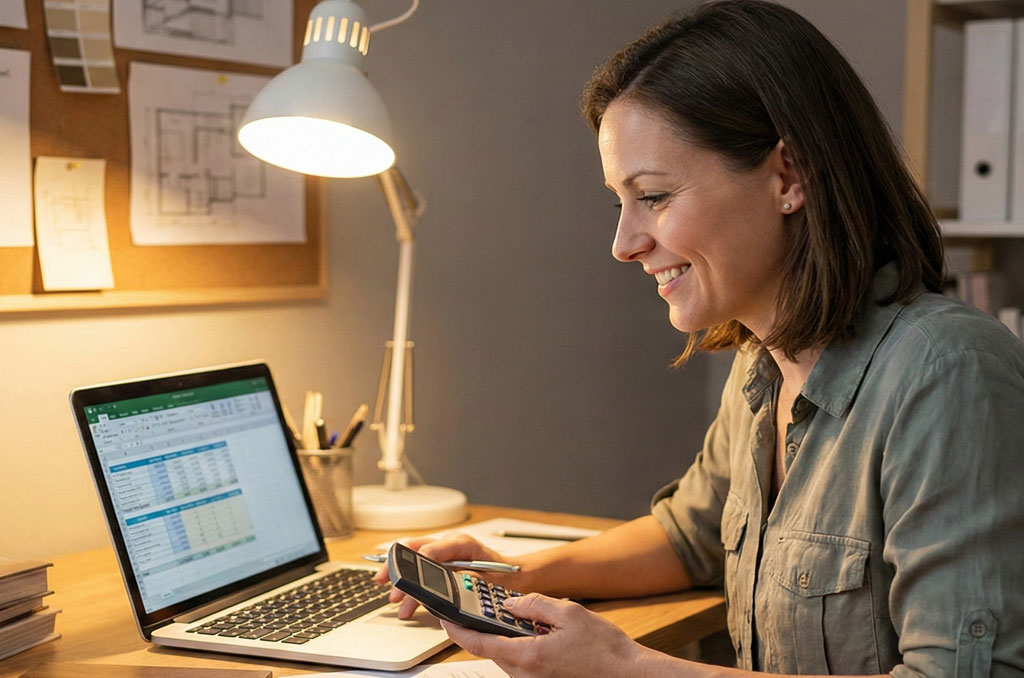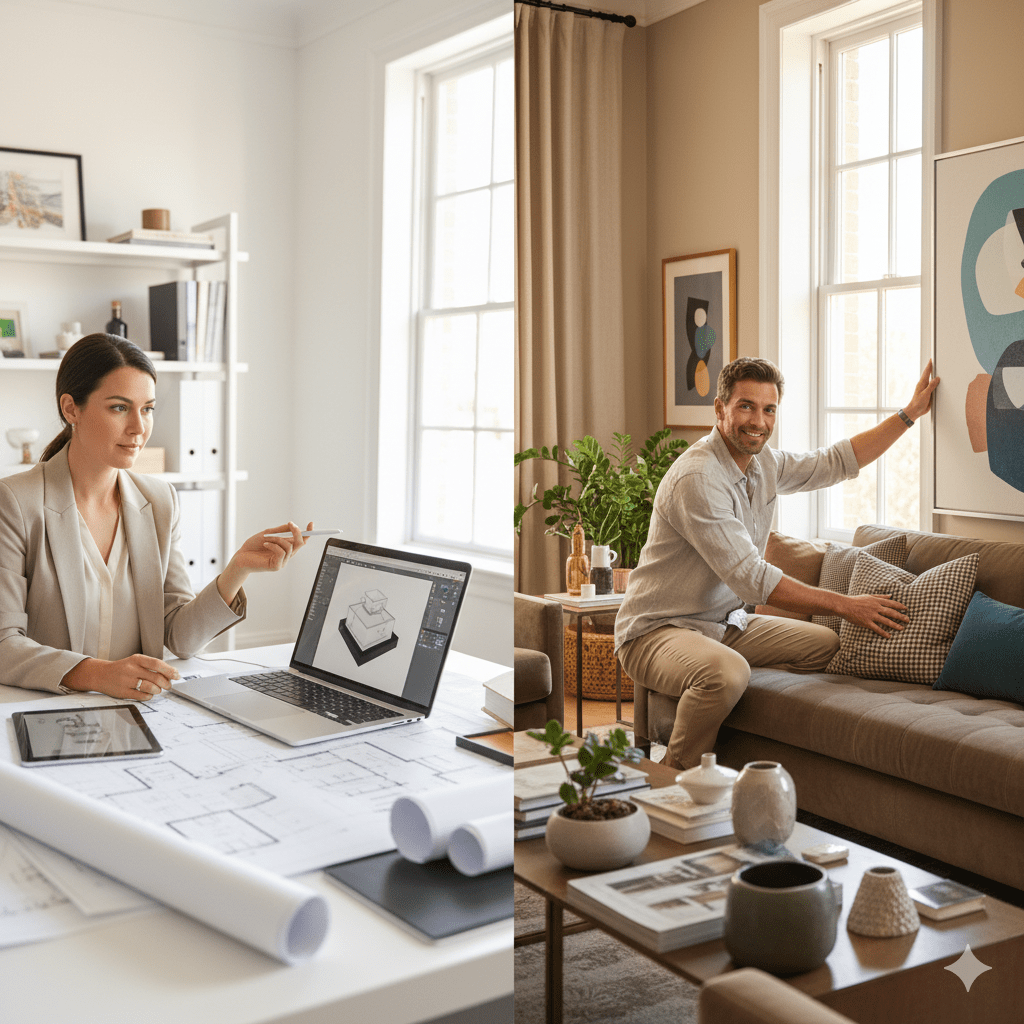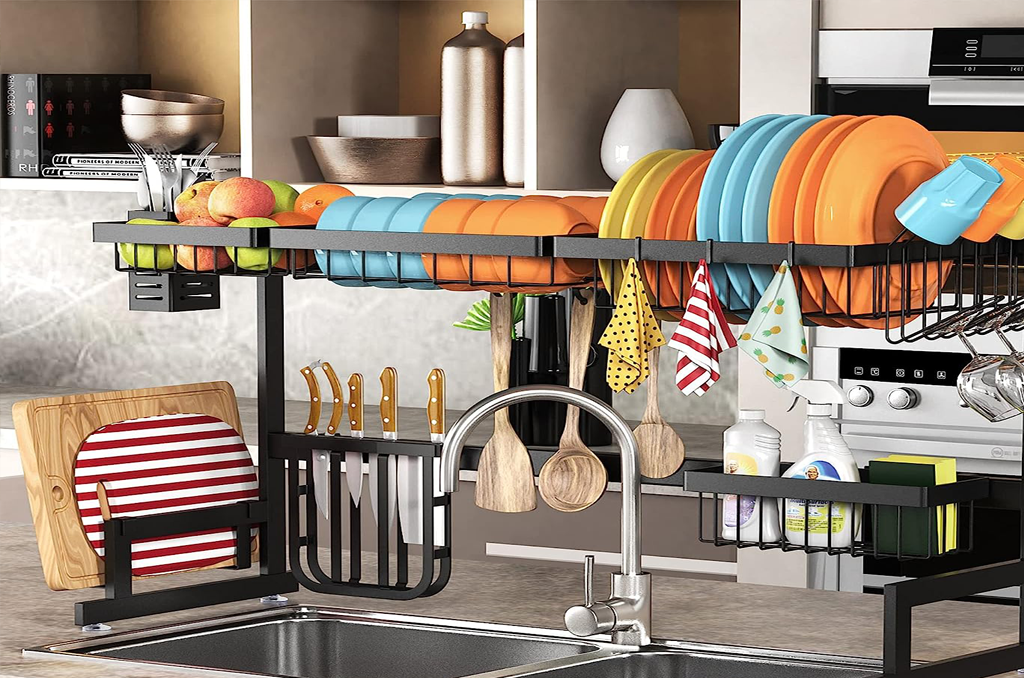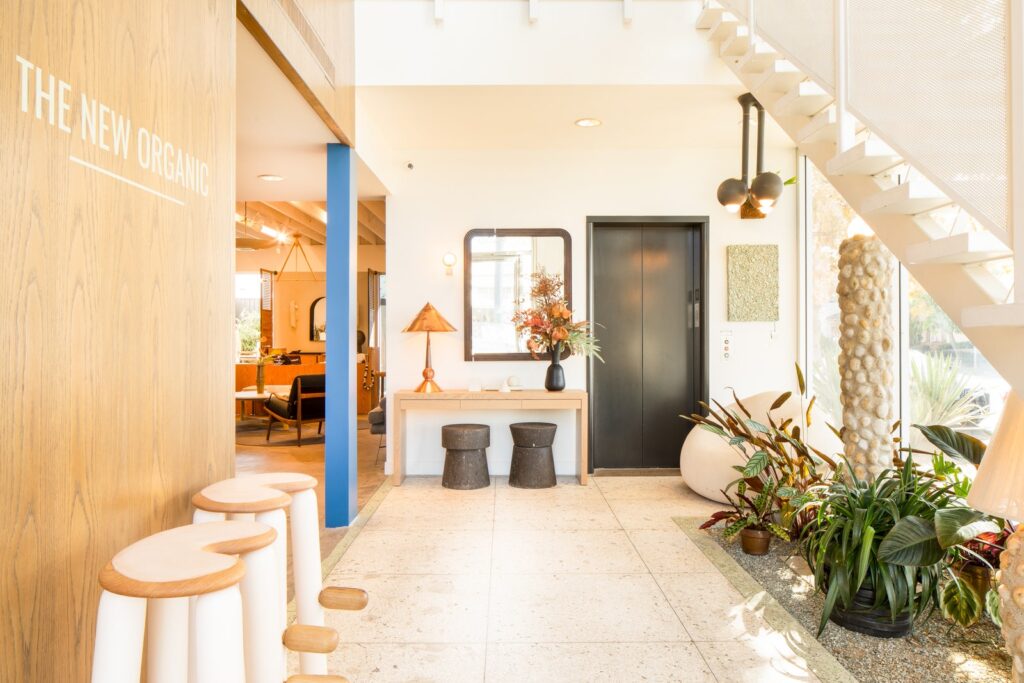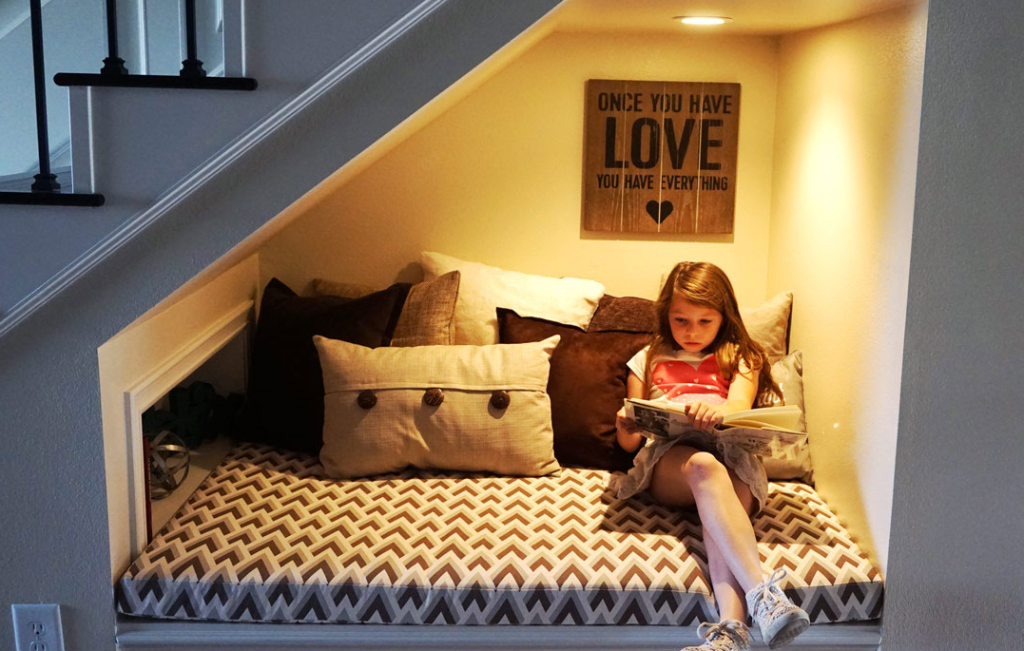
Top 10 Office Interior Design Trends for 2024
As we step into 2024, the world of office interior design is buzzing with exciting new trends transforming workplaces into dynamic, functional, and inspiring spaces. Gone are the days of dull, monotonous office cubicles; today’s office environments are designed to boost productivity, enhance well-being, and foster creativity. Whether you’re a business owner looking to refresh your office space or an employee curious about the latest in workplace design, understanding these trends can help you create a more enjoyable and efficient work environment.
 |
In recent years, the way we work has undergone significant changes, largely driven by technological advancements and a greater emphasis on employee wellness. The global shift towards remote and hybrid work models has also influenced office design, pushing companies to create spaces that are more flexible, comfortable, and conducive to various work styles. This year, we see a strong focus on integrating nature into the office, prioritizing ergonomic solutions, and utilizing technology to streamline operations.
One of the standout trends for 2024 is biophilic design, which incorporates natural elements like plants and natural light to create a more inviting and calming atmosphere. Alongside this, ergonomic furniture continues to be a priority, as businesses recognize the importance of promoting good posture and reducing physical strain. Another exciting trend is the move towards flexible workspaces, which can be easily adapted to meet the needs of different tasks and teams.
Technology also plays a crucial role in modern office design, with smart offices featuring the latest gadgets to enhance connectivity and efficiency. Sustainability remains a key concern, with many offices opting for eco-friendly materials and energy-saving solutions. Additionally, there’s a growing trend towards creating home-like comfort in the office, making workspaces feel more inviting and less formal.
Collaboration is at the heart of many modern office designs, with dedicated spaces for teamwork and innovation. At the same time, acoustic solutions are being implemented to ensure that open-plan offices don’t become too noisy. Personalization is another important trend, allowing employees to make their workspaces their own, which can lead to higher job satisfaction. Finally, health and wellness features, such as standing desks and relaxation areas, are becoming standard as companies strive to support the overall well-being of their employees.
These trends reflect the changing nature of work and highlight the importance of creating office environments that cater to the diverse needs of today’s workforce. By embracing these top 10 office interior design trends for 2024, businesses can create spaces that inspire, motivate, and support their employees in achieving their best work.
The Top 10 Office Interior Design Trends For This Year
1. Embracing Biophilic Design in Office Interiors
 Biophilic design is one of the most exciting trends in office interior design for 2024. Simply put, biophilic design is all about bringing elements of nature into the workplace. The idea is that humans have an inherent connection to nature, and incorporating natural elements into office spaces can make employees feel happier, healthier, and more productive.
Biophilic design is one of the most exciting trends in office interior design for 2024. Simply put, biophilic design is all about bringing elements of nature into the workplace. The idea is that humans have an inherent connection to nature, and incorporating natural elements into office spaces can make employees feel happier, healthier, and more productive.
Imagine walking into an office filled with lush green plants, walls adorned with ivy, and large windows that let in plenty of natural sunlight. This is the essence of biophilic design. It’s about creating an environment that feels alive and vibrant, using plants, natural materials like wood and stone, and maximizing natural light. These elements help reduce stress and improve mood, making the office a more pleasant place to be.
Incorporating plants into the office is a straightforward way to start with biophilic design. Plants not only add a touch of greenery but also improve air quality by absorbing toxins and releasing oxygen. You might see offices with living walls, where entire walls are covered in plants, or desk plants that employees can take care of. Even a few strategically placed potted plants can make a big difference.
Natural light is another key component. Offices designed with large windows or skylights can take advantage of daylight, which is not only more pleasant than artificial lighting but also helps regulate our circadian rhythms, improving sleep and overall well-being. Where natural light isn’t available, using light fixtures that mimic natural light can be a great alternative.
Materials also play a significant role in biophilic design. Instead of cold, sterile surfaces, think of warm wood finishes, stone accents, and fabrics that mimic natural textures. These materials make the office feel more inviting and comfortable. For example, wooden desks and stone countertops can add a natural touch, while bamboo flooring or wool carpets can make the space feel cozier.
Incorporating biophilic design into your office doesn’t have to be complicated or expensive. Start with simple changes like adding more plants, maximizing natural light, and using natural materials. These small adjustments can make a significant impact, creating a workspace that feels more connected to nature and more enjoyable for everyone.
 |
2. Enhancing Comfort with Ergonomic Furniture in Office Interiors
 Another key trend in office interior design for 2024 is the use of ergonomic furniture. Ergonomic furniture is specifically designed to support the human body, promoting good posture and reducing the risk of discomfort or injury. In simple terms, it’s all about making sure that the furniture in your office helps you work comfortably and efficiently.
Another key trend in office interior design for 2024 is the use of ergonomic furniture. Ergonomic furniture is specifically designed to support the human body, promoting good posture and reducing the risk of discomfort or injury. In simple terms, it’s all about making sure that the furniture in your office helps you work comfortably and efficiently.
Think about the typical office chair. An ergonomic chair is not just any chair; it has features like adjustable height, lumbar support, and a seat that supports your hips. These features help you sit correctly, reducing strain on your back and neck. When you sit in an ergonomic chair, you can adjust it to fit your body perfectly, ensuring that your feet are flat on the ground and your knees are at a 90-degree angle, which is the healthiest way to sit.
Desks are also a big part of ergonomic office furniture. Adjustable desks, also known as sit-stand desks, are becoming very popular. These desks allow you to change the height so you can alternate between sitting and standing throughout the day. Standing up periodically helps reduce the health risks associated with sitting for long periods, such as back pain and poor circulation. It’s a simple yet effective way to improve comfort and productivity.
Beyond chairs and desks, ergonomic furniture includes accessories like keyboard trays and monitor stands. A keyboard tray allows you to position your keyboard at the right height to keep your wrists straight, preventing strain. Monitor stands or adjustable monitor arms help position your computer screen at eye level, so you don’t have to hunch over or strain your neck to see your work.
Using ergonomic furniture in the office isn’t just about comfort—it’s about health and efficiency. When employees are comfortable, they can focus better and work more effectively. Moreover, reducing physical strain can decrease the number of work-related injuries, leading to fewer sick days and higher overall productivity. Investing in ergonomic furniture is a smart move for any office looking to create a healthier, happier, and more productive workplace.
Incorporating ergonomic furniture into your office design doesn’t have to be complex. Start with the basics: invest in good chairs and adjustable desks, and add ergonomic accessories like keyboard trays and monitor stands. These changes can make a big difference in how comfortable and efficient your workspace is, ensuring that everyone can work at their best.
3. Adapting to Change with Flexible Workspaces in Office Interiors
 Flexible workspaces are a major trend in office interior design for 2024, emphasizing the need for adaptability and versatility in the workplace. Unlike traditional office setups with fixed desks and rigid layouts, flexible workspaces allow for easy reconfiguration to meet different needs and preferences. This approach supports various working styles, enhances collaboration, and maximizes the use of space.
Flexible workspaces are a major trend in office interior design for 2024, emphasizing the need for adaptability and versatility in the workplace. Unlike traditional office setups with fixed desks and rigid layouts, flexible workspaces allow for easy reconfiguration to meet different needs and preferences. This approach supports various working styles, enhances collaboration, and maximizes the use of space.
Imagine an office where you can move desks and chairs around to create different setups throughout the day. In the morning, you might have a quiet corner for focused work, while in the afternoon, you can rearrange furniture for a team brainstorming session. Flexible workspaces often use movable partitions, modular furniture, and multi-purpose areas to facilitate these changes. This adaptability means that the office can quickly transform to support individual work, small group meetings, or large team gatherings.
One of the key components of flexible workspaces is modular furniture. Modular desks and seating can be easily combined or separated to create different configurations. For example, desks with wheels can be rolled together to form a large conference table or separated for individual workstations. Modular seating like sofas and chairs can be rearranged to create a lounge area or a casual meeting space. This flexibility allows employees to customize their environment to best suit their tasks.
Flexible workspaces also often include hot-desking options. Hot-desking means that instead of having assigned desks, employees can choose where to sit each day. This system can reduce the amount of space needed and promote a dynamic, collaborative atmosphere. Employees might choose to sit in a quiet area for focused work one day and in a collaborative space the next, depending on their needs. Hot-desking can also encourage interaction between different departments, fostering a more integrated company culture.
The benefits of flexible workspaces extend beyond just convenience and adaptability. By allowing employees to choose and change their work environments, these spaces can enhance job satisfaction and productivity. People can find the best setup for their current tasks, whether they need concentration or collaboration. Additionally, flexible workspaces can make better use of office space, ensuring that areas are used efficiently and effectively throughout the day.
Implementing flexible workspaces in your office doesn’t require a complete overhaul. Start with movable furniture and create a few multi-purpose areas that can serve different functions. Encourage employees to experiment with different setups and find what works best for them. By embracing flexibility, you can create a dynamic and responsive work environment that meets the diverse needs of your team, fostering a more productive and enjoyable workplace.
4. Streamlining Work with Tech Integration in Office Interiors
 Tech integration is a crucial trend in office interior design for 2024, focusing on incorporating the latest technological advancements to enhance the workplace. By integrating smart technology into office spaces, businesses can improve efficiency, connectivity, and the overall work experience. This trend is about making technology an integral part of the office environment, seamlessly blending it with the design to support daily tasks and operations.
Tech integration is a crucial trend in office interior design for 2024, focusing on incorporating the latest technological advancements to enhance the workplace. By integrating smart technology into office spaces, businesses can improve efficiency, connectivity, and the overall work experience. This trend is about making technology an integral part of the office environment, seamlessly blending it with the design to support daily tasks and operations.
Imagine walking into an office where everything is connected and easy to use. Smart lighting systems adjust the brightness and color temperature based on the time of day and the amount of natural light available, reducing eye strain and energy consumption. These systems can even be controlled via smartphone apps, allowing employees to personalize their lighting preferences.
Wireless charging stations are another great example of tech integration. Instead of dealing with tangled cords and searching for available outlets, employees can simply place their devices on charging pads built into desks or common areas. This not only keeps the workspace tidy but also ensures that devices are always charged and ready to use.
Video conferencing technology has become essential, especially with the rise of remote and hybrid work models. Integrated audio-visual equipment, such as high-quality cameras, microphones, and speakers, make virtual meetings more effective and engaging. Conference rooms equipped with large screens and seamless connectivity options enable smooth presentations and collaborations, whether participants are in the office or joining remotely.
Smart office systems also enhance security and accessibility. For instance, keyless entry systems allow employees to enter the building using their smartphones or keycards, enhancing security and convenience. Additionally, smart climate control systems adjust the temperature and ventilation based on occupancy and usage patterns, creating a comfortable environment while saving energy.
Tech integration isn’t just about gadgets; it’s about creating a more efficient and enjoyable workplace. By incorporating these technologies, offices can support a more flexible and connected work environment. Employees can collaborate more easily, access information quickly, and work comfortably, ultimately boosting productivity and satisfaction.
Embracing tech integration in your office doesn’t have to be overwhelming. Start with simple additions like wireless charging stations and smart lighting. Gradually incorporate more advanced systems, such as video conferencing setups and smart climate control. By integrating technology thoughtfully, you can create a modern, efficient, and user-friendly workspace that meets the needs of today’s dynamic work environment.
5. Going Green with Sustainable Materials in Office Interiors
One of the most significant trends in office interior design for 2024 is the use of sustainable materials. This trend focuses on making environmentally friendly choices that reduce the impact on the planet while creating a healthier workspace. Using sustainable materials means opting for resources that are renewable, recycled, or have a minimal environmental footprint.
Imagine an office where the desks are made from reclaimed wood, giving each piece a unique character while preventing deforestation. Reclaimed wood is an excellent example of a sustainable material because it repurposes wood from old buildings or furniture, reducing the need to cut down new trees. This not only preserves forests but also gives new life to materials that might otherwise go to waste.
Bamboo is another popular sustainable material in office design. Unlike traditional hardwood, bamboo grows incredibly fast and can be harvested without killing the plant. Bamboo can be used for flooring, furniture, and even decorative elements. It’s durable, stylish, and much more eco-friendly than many other options.
Low-VOC (volatile organic compounds) paints and finishes are also important in sustainable office design. Traditional paints and finishes often release harmful chemicals into the air, contributing to indoor pollution and health issues. Low-VOC alternatives significantly reduce these emissions, creating a safer and healthier indoor environment. This choice is not only better for the planet but also improves air quality for everyone in the office.
Recycled materials are a cornerstone of sustainable design. For instance, office carpets made from recycled plastic bottles or tiles made from recycled glass can help reduce waste and energy consumption. These materials often come in a variety of colors and styles, making it easy to incorporate them into any design scheme without sacrificing aesthetics.
Choosing sustainable materials doesn’t just benefit the environment; it also enhances the office atmosphere. Natural materials like wood and bamboo create a warm, inviting ambiance, while recycled elements add a modern, innovative touch. By prioritizing sustainability in office design, businesses can show their commitment to environmental responsibility, which can be a strong motivator for employees and a positive image for clients.
Incorporating sustainable materials into your office doesn’t have to be a major overhaul. Start small by selecting eco-friendly paints and finishes, then move on to larger elements like furniture and flooring. Every step towards using sustainable materials contributes to a greener office and a healthier planet, making it a worthwhile investment for any business.
6. Bringing Home-Like Comfort to Office Interiors
 In 2024, one of the most compelling trends in office interior design is the emphasis on home-like comfort. This trend aims to make office spaces feel as welcoming and comfortable as home, helping employees feel more relaxed and productive. By incorporating cozy and familiar elements, offices can become more inviting places where employees enjoy spending time.
In 2024, one of the most compelling trends in office interior design is the emphasis on home-like comfort. This trend aims to make office spaces feel as welcoming and comfortable as home, helping employees feel more relaxed and productive. By incorporating cozy and familiar elements, offices can become more inviting places where employees enjoy spending time.
Imagine walking into an office that feels more like a living room than a traditional workspace. Instead of stiff, uncomfortable chairs, there are plush sofas and armchairs. Soft rugs cover the floors, and there are cozy nooks with cushions and throws where employees can relax or brainstorm ideas. This home-like atmosphere helps reduce stress and makes the office a more pleasant place to be.
Comfortable seating is a key element of this trend. Offices are moving away from rigid, formal furniture and towards options that offer better support and comfort. Think of cushioned lounge chairs, bean bags, and sectional sofas where employees can sit comfortably for casual meetings or solo work. These pieces not only provide physical comfort but also encourage a more relaxed and creative mindset.
In addition to seating, the overall décor plays a significant role in creating a home-like environment. Warm lighting, such as floor lamps and table lamps with soft bulbs, can replace harsh fluorescent lights, creating a more soothing ambiance. Decorative elements like framed art, potted plants, and bookcases filled with books and personal items add a touch of personality and warmth to the space.
Functional amenities that you might find at home are also becoming common in office design. Kitchens or kitchenette areas equipped with coffee makers, refrigerators, and microwaves allow employees to prepare and enjoy meals and snacks just like they would at home. Some offices even include features like fireplaces or home theaters, providing unique spaces where employees can unwind or gather for informal meetings.
Creating a home-like environment in the office doesn’t mean sacrificing professionalism. It’s about finding a balance that supports both comfort and productivity. Simple changes, like adding comfortable seating and warm lighting, can make a big difference. By making the office feel more like home, businesses can enhance employee satisfaction, foster creativity, and create a workspace that people look forward to coming to every day.
Embracing home-like comfort in your office design can start with small touches. Add a few cozy chairs, incorporate some warm lighting, and bring in personal décor elements. These adjustments can transform a standard office into a welcoming haven that combines the best aspects of home and work, making it easier for employees to feel at ease and stay productive.
7. Fostering Teamwork with Collaborative Spaces in Office Interiors
 A prominent trend in office interior design for 2024 is the creation of collaborative spaces. These are designated areas designed to encourage teamwork, communication, and creative thinking. Collaborative spaces are essential for modern workplaces because they provide environments where employees can easily share ideas, solve problems together, and build strong working relationships.
A prominent trend in office interior design for 2024 is the creation of collaborative spaces. These are designated areas designed to encourage teamwork, communication, and creative thinking. Collaborative spaces are essential for modern workplaces because they provide environments where employees can easily share ideas, solve problems together, and build strong working relationships.
Picture an office with a variety of open areas equipped for different types of group activities. Instead of traditional conference rooms, there are spaces with large communal tables where teams can gather for brainstorming sessions. Comfortable seating areas with sofas and coffee tables are perfect for informal meetings and quick catch-ups. These spaces are often equipped with whiteboards, corkboards, and other tools that facilitate idea sharing and collaboration.
One key feature of collaborative spaces is flexibility. Furniture in these areas is often movable, allowing teams to reconfigure the layout to suit their needs. For example, modular desks and chairs can be arranged into a large circle for a group discussion or split into smaller clusters for breakout sessions. This flexibility ensures that the space can be adapted for various activities, from intense planning meetings to casual chats.
Technology plays a significant role in enhancing collaborative spaces. Interactive screens, video conferencing equipment, and shared digital whiteboards enable seamless communication, both within the office and with remote team members. These tools make it easy to share presentations, brainstorm ideas, and collaborate on projects in real-time, regardless of where participants are located. This integration of technology helps bridge the gap between in-person and remote collaboration.
In addition to fostering teamwork, collaborative spaces also contribute to a more dynamic and engaging work environment. They break down the barriers of traditional office setups, making it easier for employees from different departments to interact and collaborate. This cross-functional interaction can lead to innovative solutions and a stronger sense of community within the workplace.
Creating collaborative spaces in your office doesn’t require a complete redesign. Start by identifying underutilized areas that can be transformed into meeting or brainstorming zones. Add versatile furniture, like movable tables and chairs, and incorporate collaborative tools such as whiteboards and digital screens. By prioritizing collaboration in your office design, you can create a more cohesive and innovative work environment that empowers employees to work together effectively.
Incorporating collaborative spaces helps create a work culture that values teamwork and open communication. By providing dedicated areas for group activities, businesses can encourage collaboration, spark creativity, and ultimately drive better results. These spaces make it easier for employees to connect, share ideas, and work together towards common goals, fostering a more productive and enjoyable workplace.
8. Enhancing Focus with Acoustic Solutions in Office Interiors
As we look at the top office interior design trends for 2024, acoustic solutions are gaining significant attention. These solutions address one of the most common issues in modern open-plan offices: noise. By managing sound levels, acoustic solutions create a quieter, more focused work environment, allowing employees to concentrate better and be more productive.
Imagine working in an office where you can hear every phone call, conversation, and footstep. This constant noise can be incredibly distracting and stressful. Acoustic solutions, like sound-absorbing panels, carpets, and ceiling tiles, help reduce these unwanted sounds. These materials are designed to absorb sound waves, preventing them from bouncing around the room and creating a noisy environment.
One of the simplest and most effective acoustic solutions is the use of sound-absorbing panels. These panels can be mounted on walls or ceilings and come in various shapes, sizes, and colors. Not only do they reduce noise, but they can also add a stylish element to the office décor. Panels made from materials like foam, fabric, or recycled materials can blend seamlessly into the office design while effectively managing sound levels.
Carpeting is another practical solution for noise control. Hard floors, such as tile or concrete, reflect sound, making the environment noisier. In contrast, carpets and rugs absorb sound, reducing echo and background noise. Adding carpets to high-traffic areas or placing rugs under desks and in meeting rooms can significantly decrease noise levels, creating a quieter workspace.
Ceiling tiles specifically designed for acoustics can also play a crucial role in sound management. These tiles are made from materials that absorb sound, preventing it from traveling through the ceiling and into other parts of the office. Installing acoustic ceiling tiles is particularly beneficial in large, open spaces where sound can easily travel and cause distractions.
Incorporating acoustic solutions into your office design can be straightforward and highly effective. Start by identifying areas where noise is a significant issue and consider adding sound-absorbing materials like panels, carpets, and ceiling tiles. Even small changes can make a big difference in creating a more peaceful and productive work environment.
By addressing noise with acoustic solutions, offices can enhance employee concentration, reduce stress, and improve overall job satisfaction. A quieter workspace allows employees to focus better on their tasks, leading to increased efficiency and productivity. Investing in acoustic solutions is a smart move for any business looking to create a more comfortable and effective office environment.
9. Boosting Morale with Personalized Workspaces in Office Interiors
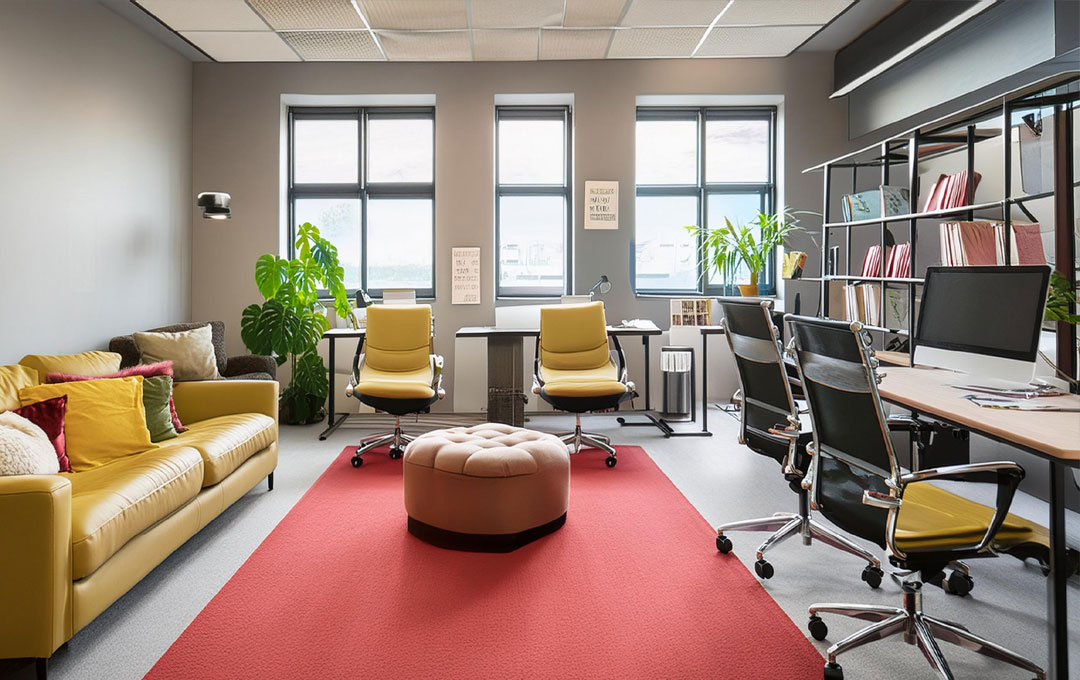 Personalized workspaces are a rising trend in office interior design for 2024, focusing on allowing employees to make their work areas their own. This trend acknowledges that employees perform better when they feel comfortable and connected to their environment. By giving employees the freedom to personalize their workspaces, companies can boost morale, enhance creativity, and improve overall job satisfaction.
Personalized workspaces are a rising trend in office interior design for 2024, focusing on allowing employees to make their work areas their own. This trend acknowledges that employees perform better when they feel comfortable and connected to their environment. By giving employees the freedom to personalize their workspaces, companies can boost morale, enhance creativity, and improve overall job satisfaction.
Imagine walking into an office where each desk tells a story about the person who works there. One desk might have family photos, another might have a small collection of plants, while another displays a favorite piece of art. This personal touch makes the office feel more human and welcoming. It’s about moving away from a one-size-fits-all approach and allowing individual expression within the workplace.
Personalized workspaces can be simple to implement. Start with flexible furniture arrangements that let employees choose how they want to set up their desks. Adjustable desks and chairs, personal storage units, and mobile filing cabinets can help employees organize their spaces according to their preferences. These options give employees control over their immediate environment, making them feel more at ease and productive.
Decorating is another important aspect of personalization. Encourage employees to bring in items that make them happy or inspire them. This could include family photos, favorite books, artwork, or even small desk plants. These personal items can make the workspace feel more like home, providing comfort and a sense of ownership. Some companies even provide a budget for employees to decorate their workspaces, showing that they value their staff’s individuality.
Technology can also enhance personalized workspaces. Allow employees to customize their computer settings, such as screen savers, desktop backgrounds, and software layouts. Providing noise-canceling headphones, personalized lighting options, or even personal whiteboards can help employees tailor their environment to their work style and preferences. These small touches can significantly improve focus and productivity.
Creating personalized workspaces doesn’t have to be complicated or expensive. Start by encouraging a culture where personalization is welcomed and supported. Provide flexible furniture options and allow employees the freedom to bring in personal items. By fostering an environment that values individuality, you can create a more engaging and motivating workplace.
Personalized workspaces reflect the idea that each employee is unique and has different needs and preferences. Allowing employees to personalize their work areas can lead to higher job satisfaction, increased creativity, and a stronger connection to the workplace. It’s a simple yet powerful way to show that you value your team’s well-being and individuality, ultimately leading to a more productive and positive work environment.
10. Prioritizing Well-being with Health and Wellness Features in Office Interiors
 In 2024, integrating health and wellness features into office interiors is a top design trend that focuses on promoting the physical and mental well-being of employees. This approach goes beyond just creating a functional workspace; it aims to make the office environment supportive of a healthier lifestyle, ultimately leading to happier and more productive employees.
In 2024, integrating health and wellness features into office interiors is a top design trend that focuses on promoting the physical and mental well-being of employees. This approach goes beyond just creating a functional workspace; it aims to make the office environment supportive of a healthier lifestyle, ultimately leading to happier and more productive employees.
Imagine an office where wellness is a core principle. Standing desks and ergonomic chairs are standard, allowing employees to switch between sitting and standing throughout the day to reduce the risks associated with prolonged sitting. These adjustable desks help improve posture, increase energy levels, and reduce back pain, making it easier for employees to stay focused and comfortable.
Natural light and air quality are also crucial aspects of health-focused office design. Large windows and skylights maximize the amount of natural light, which is not only more pleasant than artificial lighting but also helps regulate sleep patterns and improve mood. Additionally, offices equipped with advanced air filtration systems ensure that the air is clean and free from pollutants, reducing the risk of respiratory issues and enhancing overall well-being.
Breakout spaces designed for relaxation and mental breaks are another essential feature. These areas might include comfortable seating, quiet zones for meditation, and even nap pods. Such spaces provide employees with a place to recharge during the day, helping to reduce stress and prevent burnout. A quiet corner with soft lighting and calming décor can be a perfect retreat for a few minutes of relaxation or reflection.
Fitness facilities or access to exercise options can significantly enhance employee wellness. Some offices incorporate on-site gyms, yoga studios, or even simple fitness equipment like treadmills and stationary bikes. Encouraging physical activity during the workday, whether through organized fitness classes or just providing space and equipment, helps improve physical health and mental clarity.
Lastly, promoting healthy eating is a key aspect of wellness-oriented office design. Kitchens or pantry areas stocked with healthy snacks, fruits, and beverages encourage better nutrition. Some companies even offer meal programs with nutritious options or partner with local health food vendors to provide convenient, healthy meals for employees.
Implementing health and wellness features in your office doesn’t have to be an overwhelming task. Start with simple changes like improving natural light, adding plants for better air quality, and creating quiet, comfortable spaces for breaks. By prioritizing employee health and well-being, you can foster a more positive, productive, and motivated workplace, showing that you care about your team’s overall quality of life.
These health and wellness features reflect a broader understanding of what employees need to thrive. By creating an environment that supports physical and mental health, businesses can improve employee satisfaction, reduce absenteeism, and boost productivity. Investing in wellness is not just good for employees; it’s good for business too.
Conclusion
The office interior design trends of 2024 focus on creating spaces that are not only functional but also enhance the well-being and productivity of employees. By incorporating elements like biophilic design, ergonomic furniture, and smart technology, businesses can create environments that support their teams and drive success. Whether you’re redesigning an existing office or setting up a new workspace, these trends are sure to inspire and guide you toward creating a better place to work.



